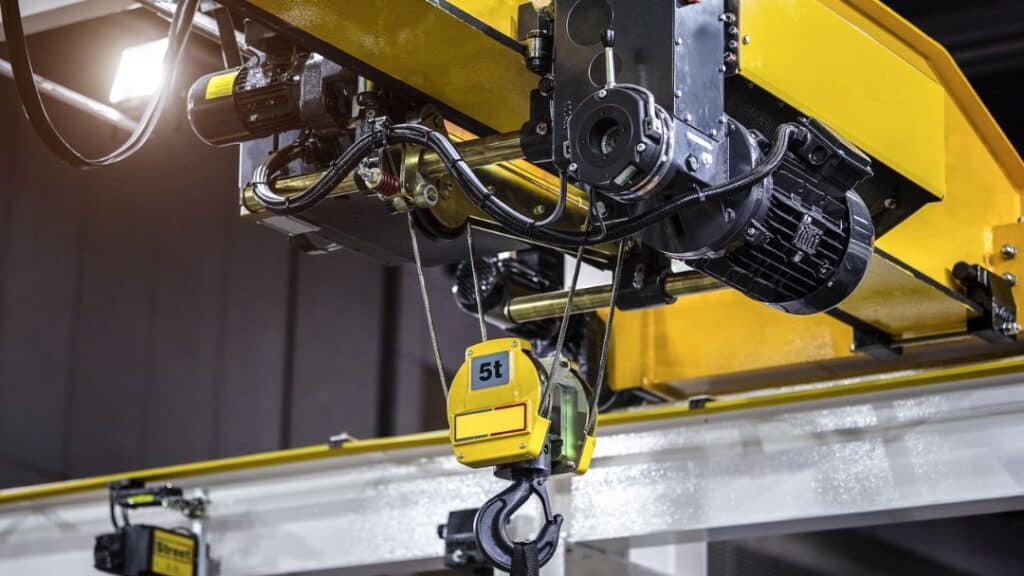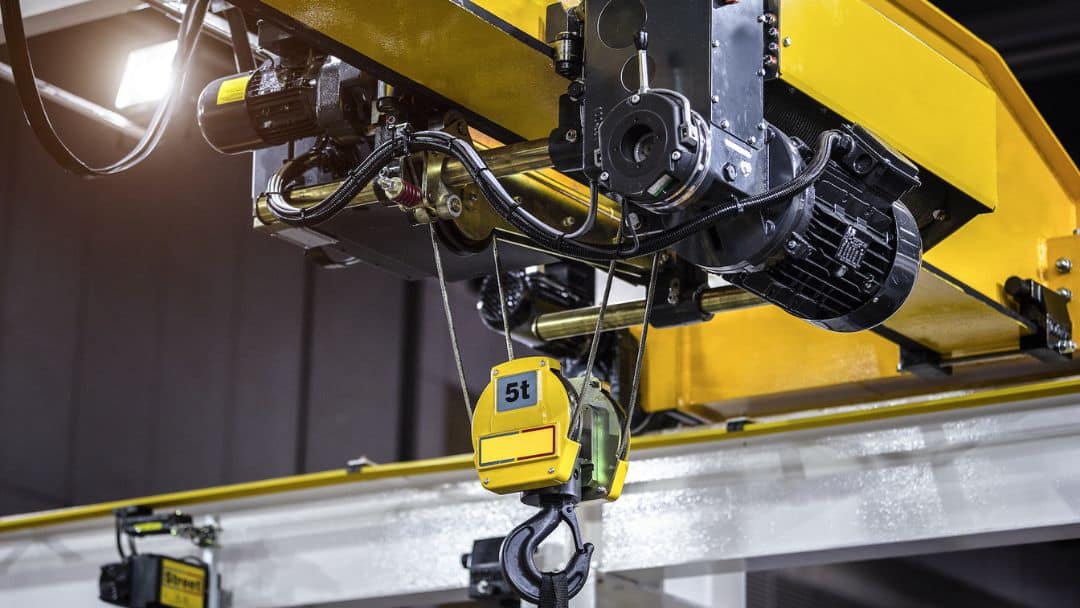Cranes and hoists are a primary component of manufacturing. Nearly every industry relies on some version of a hoist to cost-effectively manufacture goods. Once the goods are manufactured, a crane often lifts them onto a container ship, and the same happens at the destination. Without the use of cranes and hoists, the industrial age would probably never have happened.
Cranes and hoists are relatively simple machines, but they can have several components and accessories. Sometimes, even professionals are a bit hazy on the actual definitions of some of these components. Using the correct crane terminology can improve general understanding and prevent accidents caused by confusion. Today, we will provide a glossary of crane terminology using terms common in the crane industry.

Static Cranes
Static cranes, as the name implies are permanently or semi-permanently installed cranes. Static does not mean the crane does not move at all, but rather that it moves along a predetermined path. In contrast, mobile cranes are usually mounted to vehicles, allowing them to be transported from job site to job site. Gantry, jib, monorail, bridge, and overhead cranes can fall into the static crane category.
Crane
A crane is a machine that uses mechanical leverage, wire rope, and/or chains to lift and relocate heavy objects. Cranes come in several forms, such as overhead, rough terrain, and tower. Cranes often employ either electrical or pneumatic power to move objects horizontally, in addition to an attached hoist to raise and lower the object vertically.
Gantry Crane
Gantry cranes are cranes that move along a track and employ posts and girders to lift heavy objects. Gantry cranes are most often used in manufacturing to lift heavy objects vertically, transport them horizontally, and lower them back to the floor. Gantry cranes can be powered electrically, but the majority are pneumatically powered due the increased power it provides. Gantry cranes are common in automobile and modular home manufacturing because they are reliable and often have long duty cycles.
Jib Crane
Jib cranes incorporate a jib, which is the top horizontal component from which a load can be suspended. Jib cranes allow separation from the object being lifted. The jib on a jib crane is fixed in length and is often designed for a specific purpose.
Overhead Crane
Overhead cranes employ chains or wire rope to gain mechanical leverage on an object and lift it. Overhead cranes are available in a number of configurations, such as gantry, jib, bridge, workstation and monorail. Overhead cranes are typically used to vertically lift heavy objects and often employ a trolley. In this configuration, the hoist component of the crane moves the object vertically and the trolly moves it horizontally.
Tower Crane
Tower cranes are commonly used to build large structures, like a skyscraper. Tower cranes include the tower, (also known as a mast) and a jib. Tower cranes have the longest lifting range and power of any crane design. The base of a tower crane is often set in concrete to prevent the object being lifted from gaining leverage on the crane and tipping it over.
Mobile Cranes
Mobile cranes are designed to be transported from job to job with minimal setup required. In contrast to static cranes, mobile cranes are carried in or mounted on a vehicle designed to be used on site, as opposed to a permanent installation in a factory setting. Mobile cranes are used to load container ships, offer crane service (like setting roof trusses), transport building materials, and virtually any other lifting function. Mobile cranes can be manually, electrically, or pneumatically powered and are available in a wide array of designs.
Choosing construction cranes requires an understanding of the task as well as the crane. Experts in the field advise determining the load capacity and range of the crane by utilizing the load chart supplied with the crane. For example, some mobile construction cranes are chosen for their small size compared to their lifting capacity, while others are selected for their boom length or lifting height.
Crawler Cranes
Crawler cranes are cranes permanently mounted to a vehicle. Crawler cranes are typically mounted to the undercarriage of the vehicle because crawler cranes require a very low center of gravity. The low center of gravity maximizes the leverage of the crane, especially when the crane is moving. Crawler cranes are common on construction sites because they are stable without the use of additional outriggers.
Floating Crane
Also known as a crane ship or crane vessel, floating cranes describe ships that include a mounted crane as part of the vessel. Floating cranes can also be installed on barges, and are used to load and off load goods and products after transportation. Floating cranes are some of the largest cranes in existence and are commonly used for offshore construction, like a platform.
Rough Terrain Crane
Rough terrain cranes are often mobile boom cranes used to install signage and other large objects. Rough terrain cranes often have abnormally large tires to allow for clearance of ground objects and are generally four wheel drive. Rough terrain cranes are designed for off road or street use and tend to be smaller to allow access to difficult locations.
Commonly Used Crane Terms
Bridge Girder
A bridge girder refers to the horizontal component of an overhead crane, on which the trolly and hoist travel. Bridge girders can be single or double in configuration, depending on the lifting capacity required. Bridge girders are often built from a steel I-beam that transfers the weight of the object being lifted to the support columns.
Chain Hoist
Chain hoists (also known as a fairy hoist, chain block, or hand chain hoist) use an arrangement of pulleys and chain to gain mechanical leverage over heavy objects. Chain hoists are often manually operated and used to lift engines from cars. Chain hoists usually include a mounting hook that allows the hoist to be suspended above the object it is lifting.
Construction Crane
Construction crane is a common universal term used to describe cranes used in building construction. For comparison, the vast majority of cranes are used in industrial applications where the crane is fixed into position for a specific function. The term construction crane typically describes tower cranes and mobile cranes used to lift large, heavy objects like trusses and girders.
Other manually operated cranes are also used in construction, such as a fairy lift, also known as a manual chain hoist. Manual chain hoists are often attached via a hook to a structure and used to transport building materials to an upper level. Electric wire rope hoists are also considered construction cranes and are often used for the same purpose as manual chain hoists. However, electric wire rope hoists are often more powerful and capable of greater lifting power and range.
Crane Maintenance
Crane maintenance describes the periodic repair schedule cranes require to remain operational. Cranes typically require constant inspection and lubrication, which are often a large part of crane maintenance. Because cranes often handle large loads, each component must be inspected regularly for defects that could cause a failure.
Hooks, chains, and wire rope should be inspected before and after each use for signs of wear or damage. Crane maintenance schedules include these tasks and any other preventative maintenance to ensure the safety of the crane. Maintenance inspections are often performed between duty cycles to maximize the use of the crane.
Crane Safety
Crane safety involves the rules and regulations surrounding the safe use of cranes. OSHA requirements such as close proximity to the object, full adherence to load limitations, and ground safety are strictly enforced. Crane safety requirements go beyond static cranes and include transportation safety (getting the crane from job site to job site) and daily inspections of the crane. Crane safety is often the responsibility of a qualified rigger.
Electric Chain Hoist
An electric chain hoist is an electrically powered device that is suspended above an object and used to lift heavy objects. Electric chain hoists employ an electric motor and pulleys to gain a mechanical advantage over the object and lift it. Electric chain hoists typically include a hook mounted on or near the motor, from which the hoist can be suspended.
Electric chain hoists are common on construction job sites and garages due to their portability and size. Electric chain hoists are often used to transport materials to and from another level, and can be easily relocated as needed. Electric chain hoists obviously require electrical power, but are often small enough to be powered by an onsite generator when power is unavailable. The small size and portability of electric chain hoists make them nearly irreplaceable for moving heavy loads on remote job sites without temporary power.
Hoist
A hoist refers to a machine that employs pulleys and wire rope (or chain) to lift an object using mechanical leverage. A hoist can be hand powered, electrical, or pneumatic and usually includes a storage drum for the cable. The most common example of a hoist in use would be an elevator raised and lowered via a wire rope and electrical (or pneumatic) motor. Hoists can be built to nearly any size and may be permanently mounted, or portable.
Lift Director
A lift director has direct control and responsibility for the operation of the crane. In many instances the lift director will work with a qualified rigger to determine the best course of action. Due to their authority, lift directors often function as site supervisors as well.
Load
In the crane world, the term load defines the amount of force being applied to the crane by gravity. Loads are calculated by weight and include not only the object, but any part of the crane also being lifted. Load capacity for a crane is determined from information on the load chart provided with the crane. Load calculations can include the tensile strength of the wire rope, the distance from the object, and the angle at which the object will be lifted.
Load Chart
A crane load chart contains all of the pertinent information concerning the crane’s ability to lift objects. Boom angle, boom lift, and load radius data for the crane are included in the chart to allow the crane operator to safely calculate a lift. Load chart data is used to calculate the vertical distance, force, and boom angle requirements for any lift to ensure the crane has the capability to perform the task safely.
Qualified Rigger
A qualified rigger is an individual who has been deemed certified to possess the skills and experience to rig loads for lifting with cranes and hoists. Generally speaking qualified riggers will pass certain testing requirements, be at least 18 years old, and subscribe to a code of ethics. OSHA, the body governing workplace safety in the US, does not require qualified rigger certification to work as a professional. However, it is expected for any qualified rigger to have the necessary experience and training required before operating a crane.
Wire Rope
Wire rope is a high tensile strength, stranded cable used in wire rope hoists to lift heavy objects. Wire rope hoists lift objects by using a motor (often electric) to wind the wire rope around a drum. Wire rope generally has a higher lifting capacity and lifting range than its chain counterpart, making wire rope hoists very versatile.
Tower Hoist
Tower hoists are generally built on site and used primarily to transport materials vertically into a large structure. Skyscrapers use tower hoists to transport large loads vertically along a framework attached to the structure. Tower hoists often lift these materials inside a metal box, also known as a cage, using a hook attached to the cage. Tower hoists are stable because they use the stability of the structure for the strength as the building is constructed.




